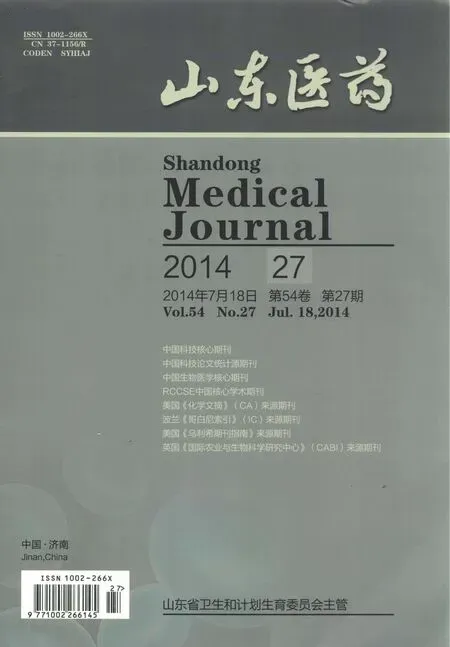胰腺癌患者化疗前后外周血NKT、IFN-γ、IL-6水平变化及意义
吴安任
(徐闻县中医院,广东徐闻524100)
胰腺癌属于较棘手的普外科恶性肿瘤,一旦确诊一般为晚期,且多无手术治疗机会,因此该类患者多采取姑息性化疗措施进行治疗[1]。目前,胰腺癌发病机制尚未完全明确,但有越来越多的证据表明胰腺癌与自然杀伤细胞(NKC)的活力下降有关[2];且有研究[3,4]表明,胰腺癌与 CD+4及 CD+26T细胞的功能异常密切相关。本文观察了化疗前后胰腺癌患者外周血自然杀伤 T细胞(NKT)、γ干扰素(IFN-γ)、IL-6水平变化,并探讨其意义。
1 资料与方法
1.1 临床资料 选取2010年1月~2013年8月我院收治的胰腺癌患者35例(胰腺癌组),男22例,女13例;年龄(57.4±12.6)岁;以上患者均为Ⅲ期,且未接受化疗;瘤体位于胰头21例,胰体8例,胰尾部6例;经病理学或ERCP送检细胞学确诊为腺癌者27例,经临床表现、实验室检查结合腹部增强CT扫描确诊8例。排除其他系统治疗以及风湿免疫性疾病,且近期内无服用激素或免疫抑制剂等情况[3]。另选取同期就诊的慢性胰腺炎[5]患者35例,男24例,女11 例;年龄(56.9±13.1)岁。健康体检志愿者35例(对照组),男21例,女14例;年龄(53.4±11.9)岁。各组一般资料比较无统计学差异,具有可比性。化疗方法:吉西他滨单药方案(21例):剂量为1 000 mg/m2,静脉滴注30 min,每周1次,连用7周,休息2周,之后每周1次,连用3周,4周重复[6]。联合方案(14例):氟尿嘧啶 425~600 mg/m2;或顺铂60~75 mg/m2;或奥沙利铂85~130 mg/m2;或卡培他滨1 000 mg/m2。在化疗开始前,采集静脉血1次;7周时第2次采集静脉血。
1.2 外周血NKT、IFN-γ、IL-6检测方法 清晨空腹抽取所有受试对象静脉血约5 mL,以上标本均抗凝保存于4℃冰箱内待测。CD3-FITC、CD16-PE、CD56-PE、IFN-γ-PE及IL-6-PE细胞因子抗体均购自南京建成生物工程研究所。多色流式细胞仪为美国BD公司生产。采用Ficoll分离获得外周血单个核细胞,随后应用尼龙毛柱获得T淋巴细胞,再免疫磁珠孵育30 min后进行磁珠而分离出NKT细胞。使用固定穿透剂对NKT胞内IFN-γ及IL-6进行染色,使用双激光光源,其中FL1和FL2荧光通道以相应同种型鼠IgG染色细胞作阴阳分界线,仔细设置各荧光通道之间的荧光补偿,每管获取细胞数1 000个;运用FACSDiva软件对NKT细胞百分含量及其胞内细胞因子水平进行分析;采用放射免疫试剂盒检测 CA199 水平[7]。
1.3 统计学方法 采用SPSS17.0统计软件。计量资料以±s表示,三组间两两比较采用单因素方差分析(ANOVA)SNK法,应用配对t检验比较化疗前后的指标变化。相关性分析采用Pearson相关分析法。P≤0.05为差异有统计学意义。
2 结果
2.1 胰腺癌组化前后及胰腺炎组、对照组NKT、IFN-γ、IL-6、CA199水平比较 见表1。
表1 胰腺癌组化前后及胰腺炎组、对照组NKT、IFN-γ、IL-6、CA199 水平比较(±s)

表1 胰腺癌组化前后及胰腺炎组、对照组NKT、IFN-γ、IL-6、CA199 水平比较(±s)
注:与对照组比较,aP <0.05;与胰腺炎组比较,bP <0.05;与同组化疗前比较,cP <0.05
组别 n NKT(%) IFN-γ(%) IL-6(%) CA199(μg/L)35化疗前 5.22±1.63ab 1.93±0.84ab 18.39±4.87ab 34.16±9.48ab化疗后 13.76±3.35c 5.71±2.42c 6.81±2.61c 13.87±4.91胰腺炎组 35 18.26±5.47 7.34±2.61 4.64±1.55a 2.38±1.47a对照组胰腺癌组35 20.75±6.81 8.41±3.27 1.80±0.37 0.83±0.21
2.2 胰腺癌组 NKT、IFN-γ、IL-6的相关性 NKT与 IFN-γ 呈正相关(r=0.785,P <0.05),IL-6 与CA199呈正相关(r=0.674,P < 0.05),NKT 与CA199 呈负相关(r= -0.894,P <0.05)。
3 讨论
Nagaraj等[8]报道,胰腺癌年发病率约 511/10万,估计每年新增近6万例,吸烟、大量饮酒、糖尿病史、胆石症史及多次生育史为发病的主要危险因素。胰腺癌发病机制仍不甚清楚,除上述危险因素外,年龄、性别、种族、地域也与此癌有一定的相关性[9]。近年来,对胰腺癌免疫机制的研究有很大进展,例如对肿瘤抗原、免疫监视、免疫逃避、免疫耐受、T淋巴细胞信号转导、细胞因子以及调节性树突状细胞的调节、共刺激分子的下调及肿瘤微环境有了一定的认识[10,11]。
由于胰腺癌患者胰导管易发生梗阻,导致常伴发慢性胰腺炎而增加诊断难度,因此临床上经常遇到胰腺癌误诊为慢性胰腺炎采用非手术治疗,后因病情恶化甚至发现癌转移才发现误诊,但此时已失去手术切除机会,这对胰腺癌的早期诊断是明显不利的[12]。NKT是一种既表达T细胞标志性的CD3分子,又表达 NK细胞的 CD16及 CD56分子的 T细胞[13];其同时具备NK和T细胞双重免疫活性,在抗肿瘤的免疫机制当中扮演重要角色[14]。研究表明,NKT细胞可在抗原刺激下体外大量扩增,呈TH0样细胞因子分泌,激活后可以产生IFN-γ等细胞因子,从而介导细胞免疫并发挥细胞毒性作用,是NKT抗肿瘤的重要机制[15]。IL-6是一种重要的炎症因子,在多种炎症及肿瘤可表达升高[16]。
本研究发现,胰腺癌组NKT、IFN-γ水平较对照组低,这与Yamasaki等[13]的结果类似,说明NKT及IFN-γ在胰腺癌及慢性胰腺炎外周血中存在差异性表达。本研究显示,胰腺癌组及胰腺炎组IL-6水平均高于对照组,且胰腺癌组高于胰腺炎组,其原因是恶性肿瘤可产生大量坏死物从而诱发局部及全身炎症,从而使IL-6水平升高[17];而慢性胰腺炎其胰腺内程度较轻,胰管压迫、堵塞相对较轻,胰腺自身消化并不严重,因此IL-6升高不如急性胰腺炎及胰腺癌明显[18]。本研究还发现,胰腺癌组化疗后NKT、IFN-γ水平均较治疗前升高,说明NKT的抗肿瘤活力有所恢复,化疗有效。而胰腺癌组化疗后IL-6水平较化疗前下降,说明胰腺细胞坏死程度减轻,炎性渗出减少。胰腺癌组CA199水平较胰腺炎及对照组高,仍然支持CA199诊断胰腺癌的特异性。相关性分析显示,NKT与IFN-γ呈正相关,IL-6与CA199呈正相关,NKT与 CA199呈负相关,说明 NKT与IFN-γ是胰腺癌患者病情转归的有利因素,而IL-6是一个反映炎症和坏死的不利因素。
[1]Avan A,Caretti V,Funel N,et al.Crizotinib inhibits metabolic inactivation of gemcitabine in c-met-driven pancreatic carcinoma[J].Cancer Res,2013,73(22):6745-6756.
[2]Andoh Y,Makino N,Yamakawa M.Dendritic cells fused with different pancreatic carcinoma cells induce different T-cell responses[J].Onco Targets Ther,2013,(6):29-40.
[3]Zhang X,Chang Li X,Xiao X,et al.CD4(+)CD62L(+)central memory T cells can be converted to Foxp3(+)T cells[J].PLoS One,2013,8(10):e77322.
[4]Yoshida T,Fujiwara W,Enomoto M,et al.An increased numbercells induced by an oral administration of lactobacillus plantarum NRIC0380 are involved in antiallergic activity[J].Int Arch Allergy Immunol,2013,162(4):283-289.
[5]Gong DJ,Zhang JM,Yu M,et al.Inhibition of SIRT1 combined with gemcitabine therapy for pancreatic carcinoma[J].Clin Interv Aging,2013,(8):889-897.
[6]Ghansah T,Vohra N,Kinney K,et al.Dendritic cell immunotherapy combined with gemcitabine chemotherapy enhances survival in a murine model of pancreatic carcinoma[J].Cancer Immunol Immunother,2013,62(6):1083-1091.
[7]Kmieciak M,Basu D,Payne KK,et al.Activated NKT cells and NK cells render T cells resistant to myeloid-derived suppressor cells and result in an effective adoptive cellular therapy against breast cancer in the FVBN202 transgenic mouse[J].J Immunol,2011,187(2):708-717.
[8]Nagaraj S,Ziske C,Strehl J,et al.Dendritic cells pulsed with alpha-galactosylceramide induce anti-tumor immunity against pancreatic cancer in vivo[J].Int Immunol,2006,18(8):1279-1283.
[9]Ghansah T,Vohra N,Kinney K,et al.Dendritic cell immunotherapy combined with gemcitabine chemotherapy enhances survival in a murine model of pancreatic carcinoma[J].Cancer Immunol Immunother,2013,62(6):1083-1091.
[10]Vonderheide RH,Bayne LJ.Inflammatory networks and immune surveillance of pancreatic carcinoma[J].Curr Opin Immunol,2013,25(2):200-205.
[11]Anson M,Viguier M,Perret C,et al.NKT cells in the liver environment interact with Wnt/β-catenin and promote the emergence of liver carcinoma[J].Med Sci(Paris),2012,28(5):473-475.
[12]Silva LD,Rocha AM,Rocha GA,et al.The presence of helicobacter pylori in the liver depends on the Th1,Th17 and treg cytokine profile of the patient[J].Mem Inst Oswaldo Cruz,2011,106(6):748-754.
[13]Yamasaki K,Horiguchi S,Kurosaki M,et al.Induction of NKT cell-specific immune responses in cancer tissues after NKT cell-targeted adoptive immunotherapy[J].Clin Immunol,2011,138(3):255-265.
[14]Kobayashi K,Tanaka Y,Horiguchi S,et al.The effect of radiotherapy on NKT cells in patients with advanced head and neck cancer[J].Cancer Immunol Immunother,2010,59(10):1503-1509.
[15]Ellermeier J,Wei J,Duewell P,et al.Therapeutic efficacy of bifunctional siRNA combining TGF-β1silencing with RIG-I activation in pancreatic cancer[J].Cancer Res,2013,73(6):1709-1720.
[16]Yamamoto T,Yanagimoto H,Satoi S,et al.Circulating CD+4CD+25regulatory T cells in patients with pancreatic cancer[J].Pancreas,2012,41(3):409-415.
[17]Ikemoto T,Yamaguchi T,Morine Y,et al.Clinical roles of increased populations of Foxp3+T cells in peripheral blood from advanced pancreatic cancer patients[J].Pancreas,2006,33(4):386-390.
[18]Miao G,Ito T,Uchikoshi F,et al.Development of donor-specific immunoregulatory T-cells after local CTLA4Ig gene transfer to pancreatic allograft[J].Transplantation,2004,78(1):59-64.

